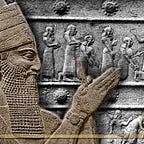Dead Sea Scrolls
Dead Sea Scrolls
In 1946, Bedouin shepherd Muhammed edh-Dhib, his cousin Jum’a Muhammed, and Khalil Musa stumbled onto — and into — a cave where jars stood waiting.
Old jars. Old jars that contained seven scrolls.
A British archaeologist and French priest rediscovered the cave — now known to be part of the Qumran cave system — in 1949.
One of the Qumram cave entrances (Wikimedia commons, Peter van der Sluijs)
As Bedouins and archaeologists combed through the caves, they found more scrolls. Even in 2021, new fragments have been unearthed. These scrolls contain, among others, the oldest known manuscripts of the Old Testament.
We know these scrolls as the Dead Sea Scrolls because they’ve been found on the northern shore of the Dead Sea, in the Judean Desert that stretches across Isreal and the West Bank.
Most of the texts are written in Hebrew, with some in Aramaic and Greek. They are thought to have been composed between the third century BC and the first century AD.
But who wrote them?
For a long time, the most accepted theory was that the Essenes, an ancient Jewish sect, were responsible for the bulk of the writing. Recently, this has been questioned and alternative theories have been proposed. For example, some researchers suggest that the scrolls were written in Jerusalem and then hidden in the desert from the Romans.
How many writers?
Identifying specific writers is highly unlikely (they generally didn’t sign their work), but a good starting point is figuring out how many different writers have contributed.
Of course, no one lives for several centuries, so there will have been many authors involved.
But what if we look at specific scrolls? Is it one scroll, one author? Unless we see a strong difference in handwriting, that’s hard to tell.
Until we let AI take a look.
A new study uses machine learning-based writer identification to scrutinize the Great Isaiah Scroll (1QIsaa), one of the original seven, and one of the largest of the Dead Sea Scrolls at more than seven meters in length. The relatively uniform handwriting makes some researchers suggest that it was written by a single scribe. Others claim to spot subtle differences indicative of two collaborating scribes. Aah, the sweet subjectivity of human perception.
Time for some machine learning.
First, the authors trained the algorithm to recognized the actual written text and not confuse it with the background of papyrus. After that, the algorithm was tasked with looking for tiny changes in each individual character that might be indicative of the subconscious, idiosyncratic flourishes of a writer.
The analysis showed a clear break in handwriting style around halfway through the scroll, a break that remained even when the researchers added some extra noise to make it harder for the algorithm.
Finally, the research team made heatmaps of individual characters that captured all the little writing details for that character throughout the entire scroll. This confirmed the half-and-half theory.
Heatmaps of two characters, with subtle differences (thickness and curvature mostly) indicating two writers. (From Popović, Dhali & Schomaker. (2021). Artificial intelligence based writer identification generates new evidence for the unknown scribes of the Dead Sea Scrolls exemplified by the Great Isaiah Scroll (1QIsaa). PLOS One. DOI: 10.1371/journal.pone.0249769)
Of course, there are variables that might have affected the result. Material degradation will always play a role in manuscripts of this age. A change in writing tools or even fatigue of the writer can influence writing style. But the clear break between two consistent styles — even if hard to spot with human eyes — leads the authors to suggest that:
Our conclusion for 1QIsaa that there were two main scribes also sheds new light on the production of biblical manuscripts in ancient Judea. We have provided new, tangible evidence that such texts were not copied by a single scribe only but that multiple scribes, while carefully mirroring another scribe’s writing style, could closely collaborate on one particular manuscript of a text that would come to be regarded and revered as biblical.
Next up, AI rewrites the bible?
